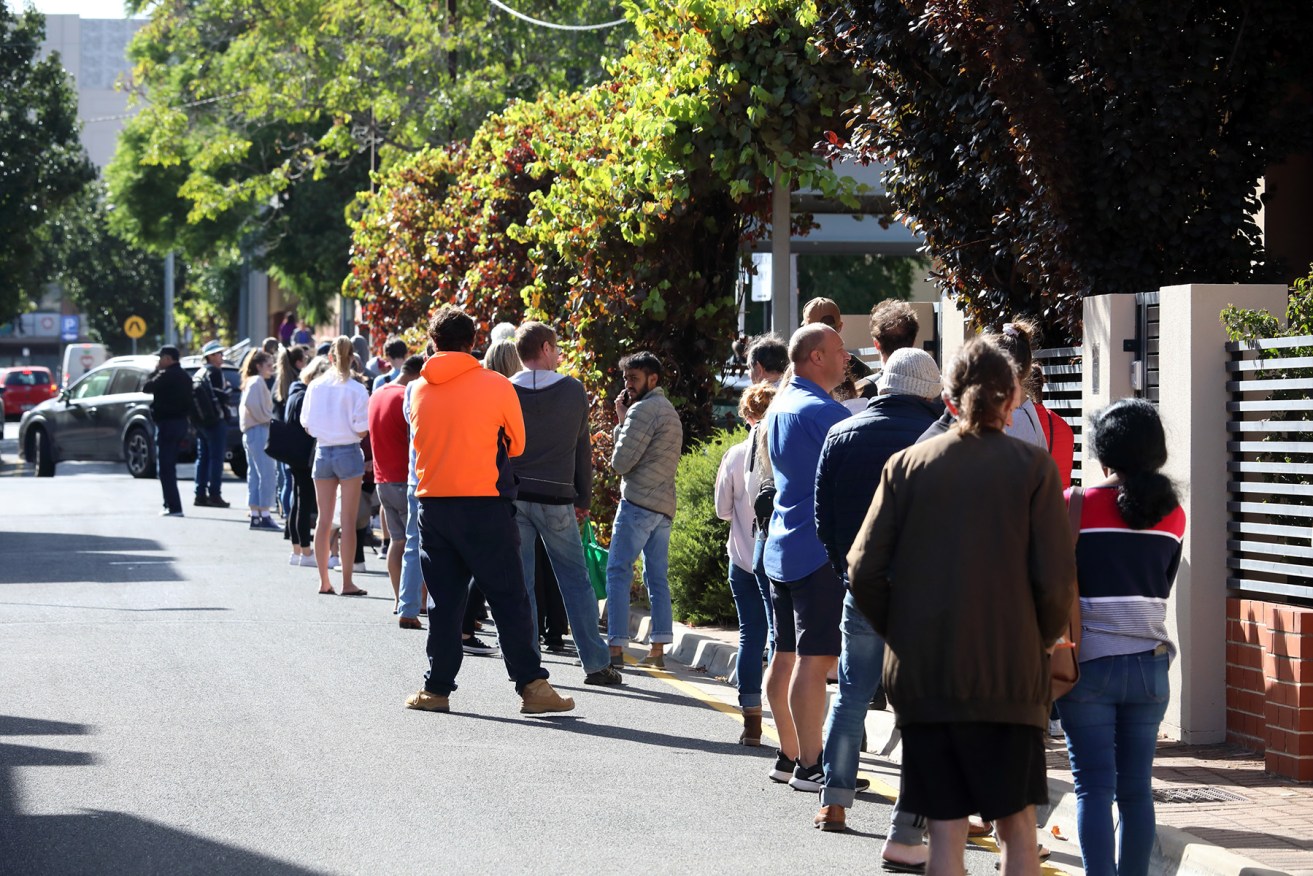A choice between community support and poverty-level Centrelink payments
As COVID-19 restrictions slowly lift and borders begin to reopen, emergency payments and increased benefits introduced to mitigate economic and social damage are about to be wound back. Besides the economic impact, a return to pre-pandemic welfare income will plunge many back into poverty, argues Catherine Earl.

Queueing at an Adelaide Centrelink office after COVID-19 restrictions shut down businesses. Photo: Tony Lewis/InDaily
This week South Australia begins the third stage of the COVID-19 crisis.
The first stage began in March when there was a real and imminent medical threat, with case numbers increasing and a fear of the unknown. Economic and social restrictions were ramping up at a rapid pace so that by April we saw workplaces closing and many people working from home, losing hours or losing their jobs altogether. At the peak, around 230,000 South Australians were out of work, underemployed or had just dropped out of the labour force – a 50% increase on just a month earlier.
By May, new COVID-19 cases had basically disappeared and the employment freefall had halted. Key government supports like Jobkeeper and JobSeeker had finally kicked in, cafes and restaurants had begun shoestring take-away operations and many other businesses were working out how to operate in some form with restrictions.
June saw us clearly in stage 2; the virus largely controlled (but an abundance of caution against its return) and a slow economic rebuild. Restrictions were slowly lifted and the number of people employed grew by 13,000. More people returned to the labour force (which perversely meant that the unemployment rate also increased). By August, the total labour force had basically returned to pre-COVID numbers, though unemployment and underemployment were still above March levels (which were already too high). There were still 177,000 South Australians looking for work or more work.
And now we reach stage 3. Despite the stage 2 economic recovery, we are not back at pre-COVID levels yet and realistically, we won’t be at least until Victoria gets the virus under control and can reopen. But stage 3 is marked by the beginnings of the winding back of major government supports.
The original JobKeeper payment ends this week, with a new rate applying from 28 September and businesses having to requalify for support. With around 200,000 South Australian workers currently receiving JobKeeper payments, this requalification could cut the numbers by more than a half – and those that still qualify will receive $300 less per fortnight. Because of the design of the JobKeeper scheme, it is hard to say what impact these changes will have on job numbers, but it is clear that some people currently hanging on to employment by virtue of JobKeeper will find themselves without work.
And when they are out of work, they will be on a very reduced rate of support because this week also sees the Coronavirus Supplement paid to those on JobSeeker (unemployment) payments cut by $300 per fortnight.
Scarily, the Supplement may disappear altogether at the end of the year, returning JobSeeker to the below-poverty-line levels of $40 a day that caused such hardship prior to the pandemic.
These cuts will have a significant effect on people and businesses reliant on those payments, and on the economy as a whole. Longer term recipients of JobSeeker (previously Newstart) are very clear about the difference the Coronavirus Supplement has made. Effectively raising the rate of JobSeeker has enabled them to pay bills and buy fresh food for the first time in a long time.
It would be nothing short of callous to return payments to the pre-COVID levels – and it would be damaging for the whole economy.
Last week ACOSS published Deloittes’ modelling which showed that the loss of the JobSeeker supplements could cost the South Australian economy $1.6b and 13,000 jobs. People looking for work not only receive money, they spend it and stimulate the economy.
Assuming we keep the virus under control, Stage 3 will be all about how our current fledgling economic recovery plays out against the shocks of withdrawing government supports. But it is not just about economic numbers and hoping growth will return to take care of everything.
It about our vision of society and what role government should play. Do we march on with a wind-back plan and return to the previous (too high) levels of unemployment and hopelessly inadequate income supports, or do we do what we did through the early stages of the COVID-19 crisis and come together to look after the people who are impacted by economic downturns?
The issues of stage 3 may linger much longer than the virus.
Dr Catherine Earl is acting CEO of South Australian Council of Social Services




